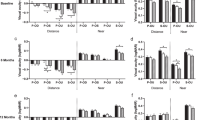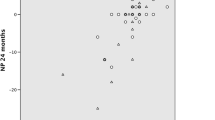Abstract
Purpose
The study aimed to observe and analyze the dynamic accommodation and binocular vision changes in myopic children after they switched from spectacles to orthokeratology (ortho-k) lenses.
Methods
Thirty-six myopic children aged 8-14 years were enrolled in this prospective, self-controlled study from West China Hospital. General information was gathered, and examinations were performed at baseline and at 1, 3, 6, and 12 months after switching to ortho-k lenses. The examination included assessments of distance/near visual acuity, distance/near horizontal and vertical ocular alignment, distance/near horizontal vergence range, accommodative amplitude, monocular/binocular accommodative facility, accommodative response, positive and negative relative accommodation (PRA/NRA), accommodation convergence/accommodation (AC/A), stereopsis, and reading ability.
Results
After the children switched to ortho-k lenses, distance and near ocular alignment showed an exophoric shift (distance: p = 0.001, near: p = 0.002), and the horizontal vergence range decreased by different degrees (convergence: distance blur point (p = 0.002), distance break point (p = 0.005), near blur point (p = 0.011), near break point (p = 0.043); divergence: distance break point (p < 0.001), distance recover point (p < 0.001), near recover point (p = 0.005)). The stereopsis ability (p < 0.001), monocular/binocular accommodative facility (p < 0.001), and PRA (p = 0.010) increased. The accommodative lag (p < 0.001), accommodative amplitude (p < 0.001), and calculated and gradient AC/A (calculated: p = 0.001, gradient: p = 0.025) decreased. The adjusted horizontal and vertical reading times and their ratio decreased (all p < 0.001).
Conclusion
The subjects showed distance and near exophoric shifts after switching to ortho-k lenses; improvements in accommodative function, stereopsis, and ocular motility; and a decrease in the binocular horizontal vergence range. The relationships between these changes and the ortho-k myopic control effects require further investigation.







Similar content being viewed by others
References
Holden BA, Fricke TR, Wilson DA, Jong M, Naidoo KS, Sankaridurg P, Wong TY, Naduvilath TJ, Resnikoff S (2016) Global prevalence of myopia and high myopia and temporal trends from 2000 through 2050. Ophthalmology 123(5):1036–1042. https://doi.org/10.1016/j.ophtha.2016.01.006
Morgan IG, French AN, Ashby RS, Guo X, Ding X, He M, Rose KA (2018) The epidemics of myopia: aetiology and prevention. Prog Retin Eye Res 62:134–149. https://doi.org/10.1016/j.preteyeres.2017.09.004
Huang J, Wen D, Wang Q, McAlinden C, Flitcroft I, Chen H, Saw SM, Chen H, Bao F, Zhao Y, Hu L, Li X, Gao R, Lu W, Du Y, Jinag Z, Yu A, Lian H, Jiang Q, Yu Y, Qu J (2016) Efficacy comparison of 16 interventions for myopia control in children: a network meta-analysis. Ophthalmology 123(4):697–708. https://doi.org/10.1016/j.ophtha.2015.11.010
Myrowitz EH (2012) Juvenile myopia progression, risk factors and interventions. Saudi journal of ophthalmology: official journal of the Saudi Ophthalmological Society 26(3):293–297. https://doi.org/10.1016/j.sjopt.2011.03.002
Koomson NY, Amedo AO, Opoku-Baah C, Ampeh PB, Ankamah E, Bonsu K (2016) Relationship between reduced accommodative lag and myopia progression. Optometry and vision science: official publication of the American Academy of Optometry 93(7):683–691. https://doi.org/10.1097/OPX.0000000000000867
Mutti DO, Mitchell GL, Hayes JR, Jones LA, Moeschberger ML, Cotter SA, Kleinstein RN, Manny RE, Twelker JD, Zadnik K, Group CS (2006) Accommodative lag before and after the onset of myopia. Invest Ophthalmol Vis Sci 47(3):837–846. https://doi.org/10.1167/iovs.05-0888
Mutti DO, Mitchell GL, Jones-Jordan LA, Cotter SA, Kleinstein RN, Manny RE, Twelker JD, Zadnik K, Group CS (2017) The response AC/A ratio before and after the onset of myopia. Invest Ophthalmol Vis Sci 58(3):1594–1602. https://doi.org/10.1167/iovs.16-19093
Lopez-Gil N, Martin J, Liu T, Bradley A, Diaz-Munoz D, Thibos LN (2013) Retinal image quality during accommodation. Ophthalmic & physiological optics: the journal of the British College of Ophthalmic Opticians 33(4):497–507. https://doi.org/10.1111/opo.12075
Berntsen DA, Sinnott LT, Mutti DO, Zadnik K, Group CS (2011) Accommodative lag and juvenile-onset myopia progression in children wearing refractive correction. Vis Res 51(9):1039–1046. https://doi.org/10.1016/j.visres.2011.02.016
Langaas T, Riddell PM (2012) Accommodative instability: relationship to progression of early onset myopia. Clin Exp Optom 95(2):153–159. https://doi.org/10.1111/j.1444-0938.2011.00699.x
Ruiz-Pomeda A, Perez-Sanchez B, Canadas P, Prieto-Garrido FL, Gutierrez-Ortega R, Villa-Collar C (2019) Binocular and accommodative function in the controlled randomized clinical trial MiSight(R) Assessment Study Spain (MASS). Graefes Arch Clin Exp Ophthalmol 257(1):207–215. https://doi.org/10.1007/s00417-018-4115-5
Hunt OA, Wolffsohn JS, Garcia-Resua C (2006) Ocular motor triad with single vision contact lenses compared to spectacle lenses. Cont Lens Anterior Eye 29(5):239–245. https://doi.org/10.1016/j.clae.2006.08.004
Jimenez R, Martinez-Almeida L, Salas C, Ortiz C (2011) Contact lenses vs spectacles in myopes: is there any difference in accommodative and binocular function? Graefe’s archive for clinical and experimental ophthalmology = Albrecht von Graefes Archiv fur klinische und experimentelle Ophthalmologie 249(6):925–935. https://doi.org/10.1007/s00417-010-1570-z
Felipe-Marquez G, Nombela-Palomo M, Cacho I, Nieto-Bona A (2015) Accommodative changes produced in response to overnight orthokeratology. Graefe's archive for clinical and experimental ophthalmology = Albrecht von Graefes Archiv fur klinische und experimentelle Ophthalmologie 253(4):619–626. https://doi.org/10.1007/s00417-014-2865-2
Felipe-Marquez G, Nombela-Palomo M, Palomo-Alvarez C, Cacho I, Nieto-Bona A (2017) Binocular function changes produced in response to overnight orthokeratology. Graefe's archive for clinical and experimental ophthalmology = Albrecht von Graefes Archiv fur klinische und experimentelle Ophthalmologie 255(1):179–188. https://doi.org/10.1007/s00417-016-3554-0
Kang P, Watt K, Chau T, Zhu J, Evans BJW, Swarbrick H (2018) The impact of orthokeratology lens wear on binocular vision and accommodation: a short-term prospective study. Contact lens & anterior eye: the journal of the British Contact Lens Association 41(6):501–506. https://doi.org/10.1016/j.clae.2018.08.002
Gifford K, Gifford P, Hendicott PL, Schmid KL (2017) Near binocular visual function in young adult orthokeratology versus soft contact lens wearers. Contact lens & anterior eye: the journal of the British Contact Lens Association 40(3):184–189. https://doi.org/10.1016/j.clae.2017.01.003
Nongpiur ME, Singh A, Saxena R, Sharma A, Sharma P (2014) To evaluate stereoacuity in patients with acquired esotropia and to determine factors associated with favourable outcomes. Indian J Ophthalmol 62(6):695–698. https://doi.org/10.4103/0301-4738.136218
Xie Y, Shi C, Tong M, Zhang M, Li T, Xu Y, Guo X, Hong Q, Chi X (2016) Developmental eye movement (DEM) test norms for Mandarin Chinese-speaking Chinese children. PLoS One 11(2):e0148481. https://doi.org/10.1371/journal.pone.0148481
Vincent SJ, Collins MJ, Read SA, Ghosh A, Chen C, Lam A, Sahota S, Vo R (2015) The short-term accommodation response to aniso-accommodative stimuli in isometropia. Ophthalmic & physiological optics : the journal of the British College of Ophthalmic Opticians 35(5):552–561. https://doi.org/10.1111/opo.12225
Adams WE, Leske DA, Hatt SR, Holmes JM (2009) Defining real change in measures of stereoacuity. Ophthalmology 116(2):281–285. https://doi.org/10.1016/j.ophtha.2008.09.012
Cho P, Cheung SW (2012) Retardation of myopia in Orthokeratology (ROMIO) study: a 2-year randomized clinical trial. Invest Ophthalmol Vis Sci 53(11):7077–7085. https://doi.org/10.1167/iovs.12-10565
Sun Y, Xu F, Zhang T, Liu M, Wang D, Chen Y, Liu Q (2015) Correction: Orthokeratology to control myopia progression: a meta-analysis. PLoS One 10(6):e0130646. https://doi.org/10.1371/journal.pone.0130646
Fulk GW, Cyert LA, Parker DE, West RW (2003) The effect of changing from glasses to soft contact lenses on myopia progression in adolescents. Ophthalmic & physiological optics : the journal of the British College of Ophthalmic Opticians 23(1):71–77
Sreenivasan V, Irving EL, Bobier WR (2008) Binocular adaptation to near addition lenses in emmetropic adults. Vis Res 48(10):1262–1269. https://doi.org/10.1016/j.visres.2008.02.015
Han X, Xu D, Ge W, Wang Z, Li X, Liu W (2018) A comparison of the effects of orthokeratology lens, medcall lens, and ordinary frame glasses on the accommodative response in myopic children. Eye & contact lens 44(4):268–271. https://doi.org/10.1097/ICL.0000000000000390
Ren Q, Yue H, Zhou Q (2016) [Effects of orthokeratology lenses on the magnitude of accommodative lag and accommodative convergence/accommodation]. Zhong nan da xue xue bao Yi xue ban = Journal of Central South University Medical sciences 41 (2):169-173. doi:10.11817/j.issn.1672-7347.2016.02.009
Orlansky G, Hopkins KB, Mitchell GL, Huang K, Frazier M, Heyman C, Scheiman M (2011) Reliability of the developmental eye movement test. Optometry and vision science : official publication of the American Academy of Optometry 88(12):1507–1519. https://doi.org/10.1097/OPX.0b013e318230f03a
Acknowledgements
The authors thank Jianglan Wang and Yue Yan, optometrists (West China Hospital, Sichuan University, Chengdu, China), for their suggestions about patient follow-up; and Xiao He, manager of the laboratory (Sichuan University, Chengdu, China), for his kind help by providing the laboratory space. We would also like to thank Pro. Liu’s postgraduate team for providing the information for the patients who met the criteria.
Availability of data and material
The data that support the findings of this study are openly available in Figshare at https://doi.org/10.6084/m9.figshare.12423461.v1 [doi].
Author information
Authors and Affiliations
Contributions
All authors contributed to the study conception and design. Material preparation, data collection, and analysis were performed by Yutong Song, Shenlin Zhu, Bi Yang, Xue Wang, Wei Ma, Guangjing Dong, and Longqian Liu. The first draft of the manuscript was written by Yutong Song and all authors commented on previous versions of the manuscript. All authors read and approved the final manuscript.
Corresponding author
Ethics declarations
Ethics approval
The study was approved by the West China Ethics Committees in 2016 before the study began.
Consent to participate
All participants and their guardians were informed of the whole study and signed the informed consent forms.
Consent for publication
All authors.
Competing interests
The authors declare no competing interests.
Code availability
Not applicable.
Additional information
Publisher’s note
Springer Nature remains neutral with regard to jurisdictional claims in published maps and institutional affiliations.
Rights and permissions
About this article
Cite this article
Song, Y., Zhu, S., Yang, B. et al. Accommodation and binocular vision changes after wearing orthokeratology lens in 8- to 14-year-old myopic children. Graefes Arch Clin Exp Ophthalmol 259, 2035–2045 (2021). https://doi.org/10.1007/s00417-021-05106-2
Received:
Revised:
Accepted:
Published:
Issue Date:
DOI: https://doi.org/10.1007/s00417-021-05106-2




